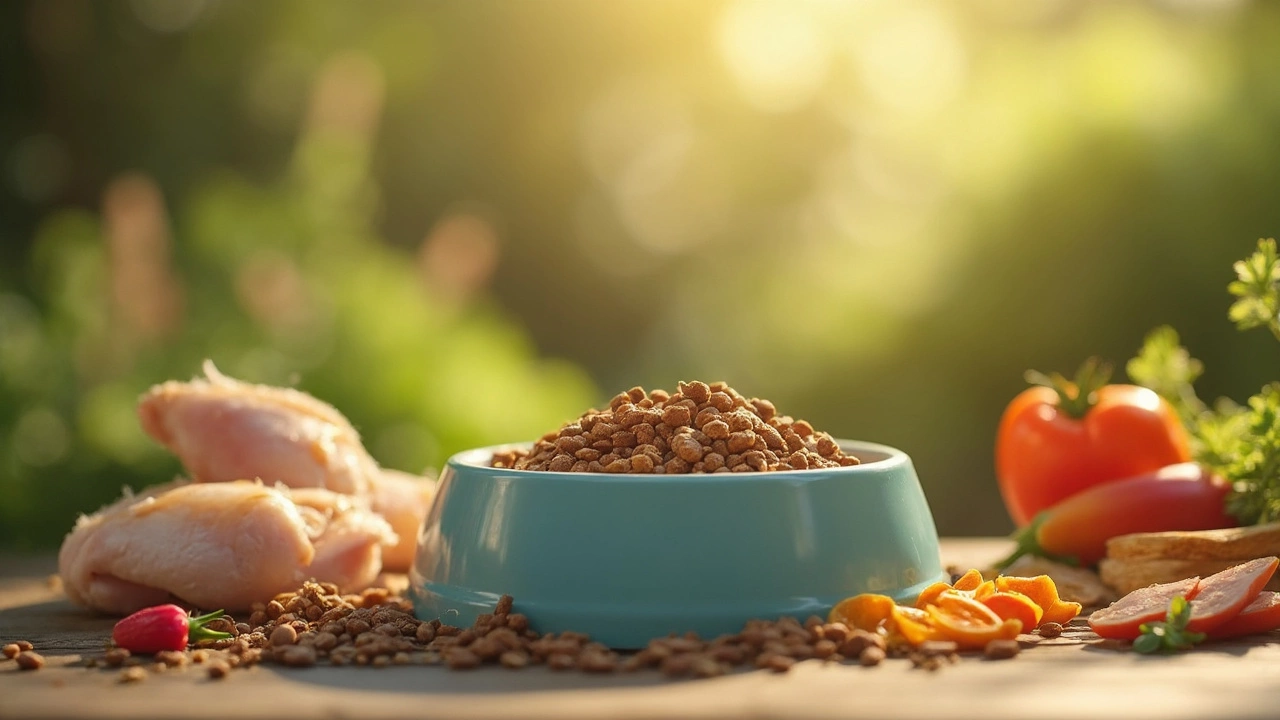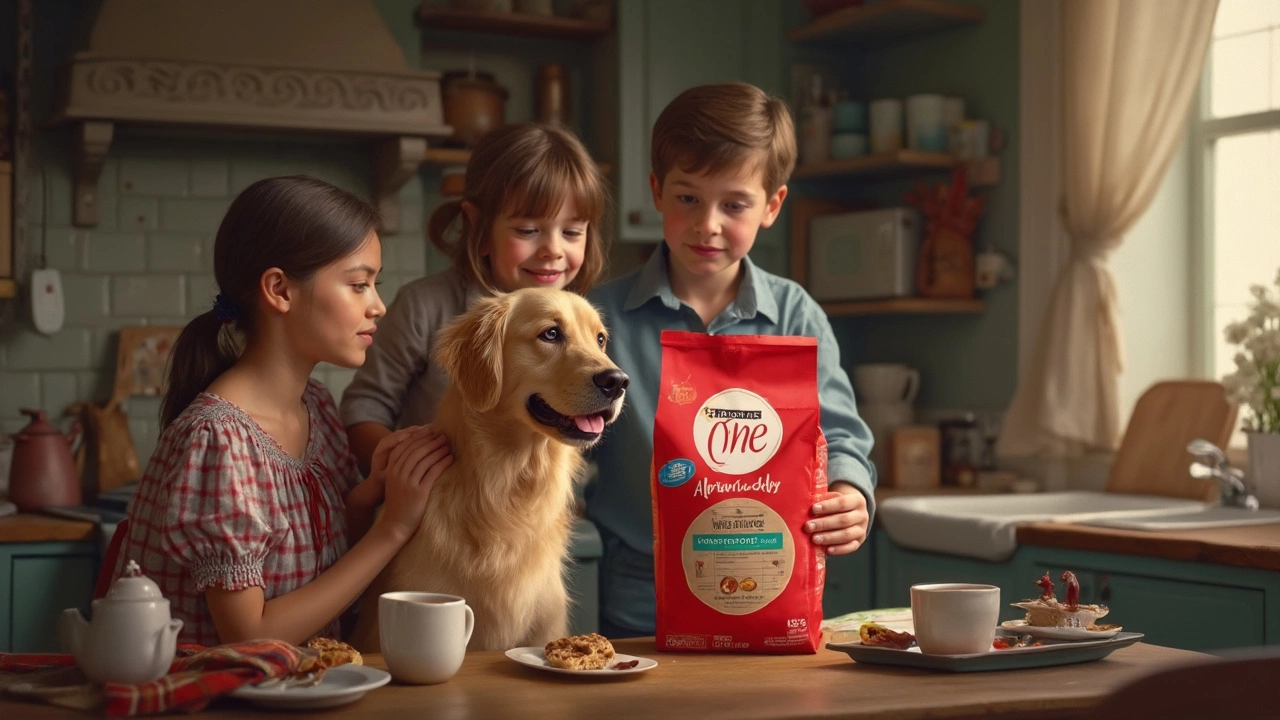Grab a bag of Purina One and you'll see a ton of promises staring back at you: “real chicken,” “supports strong muscles,” and even “recommended by veterinarians.” But the bag alone doesn’t tell you if it’s really a high-quality food or just slick marketing.
First thing you want to check? That ingredients list. The stuff at the top is what your dog will eat the most of, so it matters. For Purina One, you'll usually see protein like chicken or lamb right at the front, which is a good sign. Real animal protein helps build muscle and keeps your dog strong, especially if you've got a fetch champion or a couch potato who still wants tasty meals.
But don't get too excited just yet. It’s not all steak and chicken breasts packed in there — you’ll also see things like corn, rice, and by-products on the label. Not all of those are ‘bad’ fillers like some blogs shout about, but you need to know what each one does and if it works for your specific dog’s health, age, and activity level.
Getting to the bottom of what's actually nutritious—and what might just be there for bulk—can make a big difference in your dog's health. So, should you feed your little buddy Purina One, or look somewhere else? Let’s break down the facts, one bite at a time.
- Digging Into Purina One Ingredients
- Nutrition: Does It Deliver What Dogs Need?
- Real Reviews: What Dog Owners Are Saying
- Tips for Choosing Dog Food That Fits
Digging Into Purina One Ingredients
Let’s be honest—dog food labels can look like a chemistry test. When it comes to Purina One, you’ll usually find real meat like chicken, beef, or lamb leading the list. Dog owners like seeing named meats because these pack more actual animal protein, which helps with things like muscle tone and energy.
But pretty soon after that, you’ll spot chicken by-product meal. This isn’t straight-up meat; it’s the ground-up leftovers from the animal (like organs). While it sounds gross, these by-products actually deliver lots of vitamins, minerals, and protein. They’re not bad for dogs—just not the steak dinner you might picture.
Next, you’ll likely see grains like corn, wheat, or rice. Purina One includes these for energy and fiber. Dogs can use grains, but they don’t need them as a main ingredient. If your pup has grain allergies or sensitivities, this might be a dealbreaker. For most dogs, though, these grains are safe and digestible.
Don’t skip over the smaller stuff, either. There are added vitamins, minerals, and even probiotics in some formulas. These help support things like a shiny coat, immune system, and gut health. Antioxidants also pop up—look for ingredients like carrots or spinach. These are nice extras, not just window dressing.
Some formulas do have artificial colors and flavors (like Red 40 or Blue 2). Most dogs don’t care what color their kibble is. If you want to avoid additives, check the label for these and opt for a Purina One “Natural” version if you spot too many.
The bottom line? Purina One’s ingredient list is a classic mix of real meat, healthy extras, and some fillers and by-products. It’s not the fanciest food out there, but it does cover the basics and ticks protein and nutrients off the list without a super premium price tag.
Nutrition: Does It Deliver What Dogs Need?
If you flip over a bag of Purina One, you’ll spot a nutritional breakdown—the guaranteed analysis. Most of their formulas offer about 26% protein, which is close to what adult dogs need for daily muscle repair and energy. The main protein often comes from real chicken, so there’s a solid source for building strong muscles, not just empty calories.
Fat content lands around 16%, helping with skin, coat shine, and overall energy. Dogs aren’t afraid of good fats like we might be, and healthy fats keep their skin from getting flaky or dull. You’ll also notice they add Omega-6 fatty acids—nice for itching and scratching issues—and some vitamins, like A and E, to protect immune systems.
Puppy formulas and senior blends mix things up a bit, bumping up certain vitamins, minerals, or sometimes fiber. But across the board, Purina One sticks to AAFCO nutrient standards. That means every bag meets the minimum nutrition requirements set by the Association of American Feed Control Officials. No weird gaps in protein or big misses in minerals.
Where folks get a bit nervous is the use of corn, soy, and by-products. Are these just cheap fillers? Not exactly. Corn and rice give energy (carbs), and some dogs actually digest it well. However, if your dog’s got allergies or super sensitive guts, you may want to look at grain-free options. Meat by-products are a mix of organ meats—think livers, kidneys—not feathers or hooves. Some pups do great on these, but picky eaters or sensitive stomachs might need something simpler.
- Key nutrients covered: Protein (muscle), fat (energy, skin), carbs (quick fuel), and vitamins (whole-body health).
- Formulated to meet AAFCO standards—no big nutrition gaps.
- If your dog’s got health issues or picky tastes, always check with your vet before changing foods.
So, does Purina One deliver on nutrition? For most healthy dogs, it’s got the basics covered and some nice extras. If your dog needs a special diet or has food allergies, just scan the label for any triggers and talk to your vet for a second opinion. Purina One’s not boutique, but it’s not bare bones, either.

Real Reviews: What Dog Owners Are Saying
When it comes to switching up your dog's food, you want the scoop from real dog parents who’ve already been there. Lots of folks online have tried Purina One, and their stories are a mixed bag—mostly positive, but not without a few warnings.
The biggest thing people like? Dogs seem to dig the taste, even the picky ones. Plenty of reviews on Chewy and Amazon mention dogs who usually snub kibble but actually clear their bowls with this stuff. Some owners even say their pets have more energy and shinier coats after a couple weeks on Purina One.
| Reported Benefit | Percentage of Reviews |
|---|---|
| Dog liked the taste | Approx. 80% |
| Noticed better coat/skin | About 60% |
| Improved digestion | Roughly 50% |
| Allergy/health issues | Less than 10% |
But it's not a perfect scorecard. Some reviewers complain about upset stomachs, especially right after switching foods. That’s not unusual with any new kibble, so it’s smart to transition slowly by mixing old food with the new one for about a week.
A handful of dog owners with pups that have allergies or sensitivities say Purina One wasn’t the best fit. Corn, wheat, and chicken are common triggers, so if your dog’s got a sensitive tummy or skin, read that ingredient label closely—they make grain-free and special formulas, but you do need to check.
On sites like Dog Food Advisor, Purina One usually gets ratings between 3.5 to 4 stars out of 5. Not exactly luxury, but way better than bargain-basement brands. Vets even point out that it meets the AAFCO standards for balanced nutrition, which is a good benchmark.
- Always introduce new food bit by bit to avoid tummy troubles.
- Watch your dog’s stool, coat, and energy when changing diets—these are your best signs something’s working (or not).
- If you spot itchiness or digestive problems, talk to your vet and consider a different recipe.
Bottom line: The majority of dogs do just fine on Purina One, and most pet parents report happy, healthy pets who love mealtime. If you’re still on the fence, a small trial bag can help you decide—with less risk and less waste if your dog turns up their nose.
Tips for Choosing Dog Food That Fits
Picking the right food for your dog isn’t just about grabbing whatever has a pretty bag or even what your friend feeds their pup. What you put in your dog’s bowl shapes their health, mood, coat, and even how often you have to lug that poop bag on walks. Here’s what to focus on to make sure you’re giving your pet what really works for them.
- Check the ingredient list. Ingredients are listed in order by weight. Your goal? See real meat or fish first. Food that kicks off with "chicken meal" or "beef by-product" means it’s processed stuff, which might have lower protein quality than whole meats.
- Look for an AAFCO statement. This proves the food meets the basic nutritional needs for your dog’s age and size. It's not just marketing fluff; AAFCO standards are regulated.
- Watch out for common allergies. Lots of dogs react to chicken, beef, corn, soy, or wheat. If your dog’s itchy or has digestion issues, try swapping out the main protein source and see how it goes.
- Think about life stage. Puppy, adult, and senior foods are balanced differently. For example, puppies need more protein (at least 22%) and fat for growth, while seniors often do better with fewer calories and joint support ingredients.
- Know your dog’s activity level. If your dog is a couch potato, high-calorie food can add pounds fast. For active or working breeds, they’ll need more protein and fat for energy.
If labels start to look like a mix of science and mystery, it helps to compare key stats at a glance. Here’s a quick breakdown for the most common metrics in dry dog food:
| Nutrient | Typical Range | What It Means |
|---|---|---|
| Protein (%) | 20-32 | More is better for puppies, less active dogs can go lower |
| Fat (%) | 8-18 | Gives energy, but watch out for chubby pups |
| Fiber (%) | 3-5 | Helps digestion, can reduce loose stools |
| Calories (kcal/cup) | 300-450 | Bigger number means higher energy, small dogs or less active pets need less |
Don’t forget your vet — they’re a goldmine of advice when your dog needs a special diet or you’re stuck between brands. Get a second opinion if you have doubts about any ingredient or claim. And if you do try a new food, give it at least 2 weeks; sudden switches can cause tummy troubles even in a healthy dog.
In the end, there’s no one-size-fits-all answer. Your dog’s best food is the one that fits their needs, keeps their skin clear, coat shiny, and bathroom trips normal, without breaking the bank. Watching your dog thrive is the best proof you’ve picked the right chow — not just what the commercials say.

